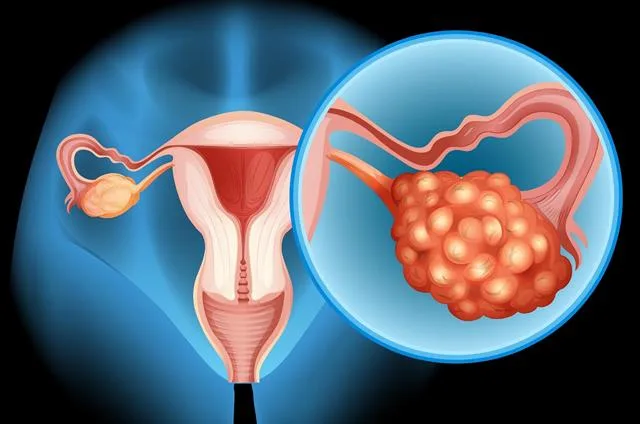What Is Ovarian Cancer?
Ovarian cancer is a serious disease in which abnormal cells in the ovaries grow uncontrollably and form tumors. The ovaries are two small female reproductive glands responsible for producing eggs and female hormones such as estrogen and progesterone.
When these cancerous cells multiply and spread, they can affect surrounding organs and tissues, making early detection and treatment critical.
Types of Ovarian Cancer
There are several types of ovarian cancer, with epithelial ovarian cancer being the most common. This type begins in the thin layer of tissue covering the outside of the ovary.
Other related types include:
- Fallopian Tube Cancer: Begins in the lining of the fallopian tubes that connect the ovaries to the uterus.
- Primary Peritoneal Cancer: Forms in the tissue lining the abdomen (peritoneum). It behaves like epithelial ovarian cancer and is treated the same way.
Less common types of ovarian cancer include:
- Malignant Germ Cell Tumors: Originate from the egg-producing cells.
- Stromal Tumors: Develop in the hormone-producing tissue of the ovaries.
What Causes Ovarian Cancer?
Ovarian cancer is caused by genetic mutations that lead to abnormal cell growth. These mutations may be:
- Acquired during a person’s lifetime (sporadic)
- Inherited, meaning passed down from parents (hereditary)
Inherited ovarian cancer is often linked to specific gene mutations, particularly BRCA1 and BRCA2. These same mutations also increase the risk of breast cancer and other types.
Other contributing factors may include environmental exposures and lifestyle choices, although the exact cause of many ovarian cancers remains unknown.
Who Is at Risk for Ovarian Cancer?
You’re more likely to develop ovarian cancer if you:
- Have a family history of ovarian cancer (mother, sister, aunt, or grandmother)
- Carry inherited BRCA1 or BRCA2 gene mutations
- Have Lynch syndrome or other inherited cancer syndromes
- Have been diagnosed with endometriosis
- Have taken hormone replacement therapy
- Are overweight or obese
- Are taller than average
- Are postmenopausal
- Have never been pregnant
Understanding your personal and family medical history can help assess your risk and guide screening decisions.
Symptoms of Ovarian Cancer
Ovarian cancer is often called a “silent killer” because early symptoms can be subtle or mistaken for other common issues. However, key warning signs may include:
- Persistent abdominal or pelvic pain
- Bloating, swelling, or pressure in the belly
- Frequent or urgent urination
- Difficulty eating or feeling full quickly
- Constipation, gas, or other gastrointestinal issues
- A lump or mass in the pelvic area
If these symptoms are new, persistent, and worsening, it’s important to see a healthcare provider.
How Is Ovarian Cancer Diagnosed?
Diagnosis typically involves:
- A review of medical and family history
- A physical and pelvic examination
- Imaging tests such as ultrasound, CT scan, or MRI
- Blood tests, including the CA-125 test, a tumor marker often elevated in ovarian cancer
A biopsy, usually performed during surgery, is the only way to confirm the diagnosis. The tumor is examined to determine its type, stage, and grade, guiding the treatment plan.
Ovarian Cancer Treatment Options
Treatment depends on the type and stage of the cancer and may include:
1. Surgery
- The primary method to remove as much of the cancer as possible
- May include removal of one or both ovaries, fallopian tubes, uterus, and nearby tissues
2. Chemotherapy
- Drugs are used to kill cancer cells or stop them from growing
- Often used after surgery to destroy any remaining cancer cells
3. Targeted Therapy
- Medications or substances that attack specific cancer cell features
- May cause fewer side effects compared to traditional chemotherapy
In some cases, immunotherapy or participation in clinical trials may be recommended, especially for advanced or recurrent ovarian cancer.
Early Detection Saves Lives
Because ovarian cancer often isn’t detected until it’s advanced, awareness of symptoms and regular medical checkups are crucial—especially if you have risk factors like family history or genetic predisposition. Genetic testing and counseling can also provide insight into your personal risk.




+ There are no comments
Add yours